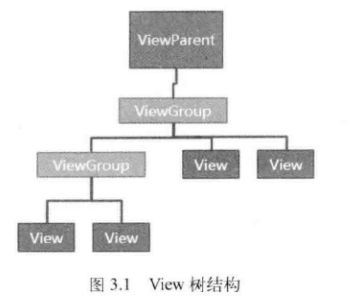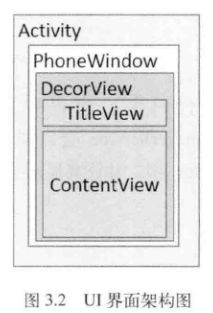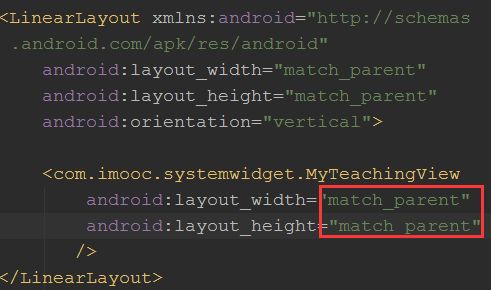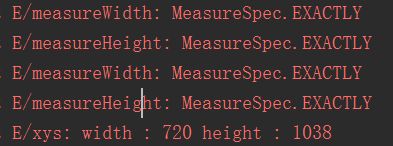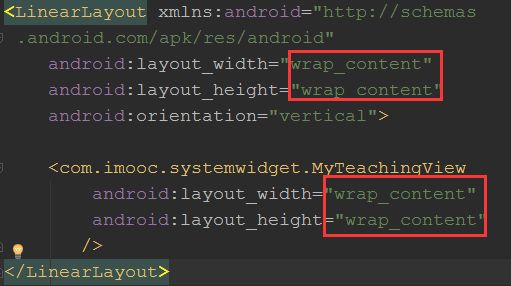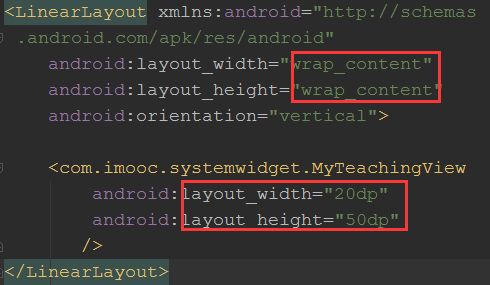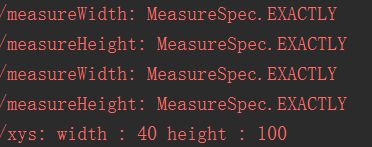本章内容预览:
3.1 Android控件架构
3.2 View的测量
3.3 View的绘制
3.4 ViewGroup的测量
3.5 ViewGroup的绘制
3.6 自定义View
3.6.1 对现有控件进行拓展
3.6.2 创建复合控件
3.6.2 重写View来实现全新的控件
3.7 自定义ViewGroup
3.8 事件拦截机制分析
正文
3.1 Android控件架构
Android的每个控件都是占一块矩形的区域,大致的分两类,View和ViewGroup,ViewGroup控件作为父控件可以包含多个View控件,并管理其包含的View控件整个界面上的控件形成了一个树形结构,也就是我们常说的控件树,上层控件负责下层控件的测量和绘制,并且传递交互事件,通过findviewbyid()这个方法来获取,其实就是遍历查找,在树形图的顶部都有一个ViewParent对象,这就是控制核心,所有的交互管理事件都是由它统一调度和分配,从而进行整个视图的控制
我们可以看到,每个activity都有一个window对象,在Android中,window对象通常由一个phonewindow去实现的,phonewindow将一个DecorView设置为整个窗口的根View,DecorView作为窗口界面的顶层视图,封装了一些通用的方法,可以说,DecorView将要显示的内容都给了phonewindow,这里面所有的View监听,都是通过winsowmanagerService来接收的,通过相应的回调来OnClicListener,在显示上,他将屏幕分成了两部分,一个title一个content,看到这里,大家应该能看到一个熟悉的界面ContentView,它是一个ID为content分framelayout,activity_main.xml就是设置在这个framelayout里面
在代码中当程序onCreate()时,也就设置了layout,执行完后,activitymanagerservice会直接调用onResume,这个时候系统会把整个DecorView添加到phonewindow,从而最终完成界面的绘制。
3.2 View的测量
Android系统在绘制View前,必须先对View进行测量,即告诉系统该画一个多大的View。这个过程在onMeasure( )中进行
MeasureSpec:
帮助测量View
MeasureSpec是一个32位的int值,高2位为测量的模式,低30位为测量的大小.
测量的模式:
- EXACTLY:精确值模式
当layout_width或layout_height属性值为特定值,或者为match_parent,则系统使用的是EXACTY- AT_MOST:最大值模式
当layout_width或layout_height属性值为wrap_content时,此时控件的尺寸不超过父控件允许的最大尺寸- UNSPECIFIED:
不指定大小,View想要多大就多大,通常情况下在绘制自定义View时才使用。
注意: View默认的onMeasure()只支持EXACTLY模式,(具体值,match_parent),如果自定义View想要支持wrap_content属性,则应该重新onMeasure()来指定wrap_content时的大小。
如何进行View的测量
- 重写onMeasure()方法,把测量到的宽高值作为参数传递给setMeasuredDimension()
protected void onMeasure(int widthMeasureSpec, int heightMeasureSpec) {
setMeasuredDimension(measureWidth(widthMeasureSpec),measureHeight(heightMeasureSpec));
}
如何自定义测量值
int specMode=MeasureSpec.getMode(measureSpec);
int specSize=MeasureSpec.getSize(measureSpec);
当specMode为EXACTLY,直接使用指定的specSize,当specMode为其它两种模式,需要给它默认的大小。特别当指定wrap_content属性,即AT_MOST模式,则需要取出我们指定的大小和sepcSize中最小的一个来作为最终的观测值。
模板代码:
private int measureWidth(int measureSpec) {
int result=0;
int specMode=MeasureSpec.getMode(measureSpec);
int specSize=MeasureSpec.getSize(measureSpec);
if(specMode==MeasureSpec.EXACTLY){
result=specSize;
Log.e("measureWidth","MeasureSpec.EXACTLY");
}else {
result=200;
if(specMode==MeasureSpec.AT_MOST){
result=Math.min(200,specSize);
Log.e("measureWidth","MeasureSpec.AT_MOST");
}
}
return result;
}
运行结果展示:
1.3 1.4
1.5
3.3 View的绘制
重写onDraw()方法
3.4 ViewGroup的测量
当ViewGroup的大小为wrap_content,ViewGroup需要对所有子View进行遍历(从而调用子View的onMeasure()方法来获得每个子View的测量值),以便获得所有子View的大小,从而确定自己的大小。
而在其他模式下则通过具体的指定值来确定自身大小。
重写onLayout()摆放子View的位置
3.5 ViewGroup的绘制
ViewGroup在一般情况下是不会绘制的,因为他本身没有需要绘制的东西,如果不是指定ViewGroup的背景颜色,他连onDraw()都不会调用,但是ViewGroup会使用dispatchDraw()来绘制其他子View,其过程同样是遍历所哟普的子View,并调用子View的绘制方法来完成绘制的
3.6 自定义View
View中重要的回调方法:
- onFinishInflate():从XML加载组件后回调
- onSizeChanged():组件大小改变时回调
- onMeasure():回调该方法来进行测量
- onLayout():回调该方法来确定显示的位置
- onTouchEvent():监听到触摸事件时回调
实现自定义View的三种方式:
- 对现有控件进行拓展
- 通过组合实现新的控件
- 重写View实现新的控件
3.6.1 对现有控件进行拓展
一般通过重写onDraw()方法
@Override
protected void onDraw(Canvas canvas) {
//在回调父类之前,实现自己的逻辑,对textview来说就是绘制文本内容前
super.onDraw(canvas);
//在回调父类之后,实现自己的逻辑,对textview来说就是绘制文本内容后
}
3.6.2 创建复合控件
创建一个复合控件可以很好的创建出具有重要功能的控件集合,这种方式经常需要继承一个合适的ViewGroup,再给他添加指定功能的控件,从而组成一个新的合适的控件,通过这种方式创建的控件,我们一般都会给他指定的一些属性,让他具有更强的扩展性,下面就以一个TopBar为例子,讲解如何创建复合控件
3.6.2.1 定义属性
res --- values --- attrs.xml
3.6.2.2 获取属性值
// 通过这个方法,将你在atts.xml中定义的declare-styleable
// 的所有属性的值存储到TypedArray中
TypedArray ta = context.obtainStyledAttributes(attrs,
R.styleable.TopBar);
// 从TypedArray中取出对应的值来为要设置的属性赋值
mLeftTextColor = ta.getColor(
R.styleable.TopBar_leftTextColor, 0);
3.6.2.3 组合控件
mLeftButton = new Button(context);
mRightButton = new Button(context);
mTitleView = new TextView(context);
// 为创建的组件元素赋值
// 值就来源于我们在引用的xml文件中给对应属性的赋值
mLeftButton.setTextColor(mLeftTextColor);
mLeftButton.setBackground(mLeftBackground);
mLeftButton.setText(mLeftText);
mRightButton.setTextColor(mRightTextColor);
mRightButton.setBackground(mRightBackground);
mRightButton.setText(mRightText);
mTitleView.setText(mTitle);
mTitleView.setTextColor(mTitleTextColor);
mTitleView.setTextSize(mTitleTextSize);
mTitleView.setGravity(Gravity.CENTER);
// 为组件元素设置相应的布局元素
mLeftParams = new LayoutParams(
LayoutParams.WRAP_CONTENT,
LayoutParams.MATCH_PARENT);
mLeftParams.addRule(RelativeLayout.ALIGN_PARENT_LEFT, TRUE);
// 添加到ViewGroup
addView(mLeftButton, mLeftParams);
mRightParams = new LayoutParams(
LayoutParams.WRAP_CONTENT,
LayoutParams.MATCH_PARENT);
mRightParams.addRule(RelativeLayout.ALIGN_PARENT_RIGHT, TRUE);
addView(mRightButton, mRightParams);
mTitlepParams = new LayoutParams(
LayoutParams.WRAP_CONTENT,
LayoutParams.MATCH_PARENT);
mTitlepParams.addRule(RelativeLayout.CENTER_IN_PARENT, TRUE);
addView(mTitleView, mTitlepParams);
3.6.2.4 定义接口
// 接口对象,实现回调机制,在回调方法中
// 通过映射的接口对象调用接口中的方法
// 而不用去考虑如何实现,具体的实现由调用者去创建
public interface topbarClickListener {
// 左按钮点击事件
void leftClick();
// 右按钮点击事件
void rightClick();
}
3.6.2.5 暴露接口给调用者 实现接口回调 提供public方法设置
// 暴露一个方法给调用者来注册接口回调
// 通过接口来获得回调者对接口方法的实现
public void setOnTopbarClickListener(topbarClickListener mListener) {
this.mListener = mListener;
}
3.6.2.6 引用UI模板
在布局文件中引入命名空间:
xmlns:custom="http://schemas.android.com/apk/res-auto"
public class TopBar extends RelativeLayout {
// 包含topbar上的元素:左按钮、右按钮、标题
private Button mLeftButton, mRightButton;
private TextView mTitleView;
// 布局属性,用来控制组件元素在ViewGroup中的位置
private LayoutParams mLeftParams, mTitlepParams, mRightParams;
// 左按钮的属性值,即我们在atts.xml文件中定义的属性
private int mLeftTextColor;
private Drawable mLeftBackground;
private String mLeftText;
// 右按钮的属性值,即我们在atts.xml文件中定义的属性
private int mRightTextColor;
private Drawable mRightBackground;
private String mRightText;
// 标题的属性值,即我们在atts.xml文件中定义的属性
private float mTitleTextSize;
private int mTitleTextColor;
private String mTitle;
// 映射传入的接口对象
private topbarClickListener mListener;
public TopBar(Context context, AttributeSet attrs, int defStyle) {
super(context, attrs, defStyle);
}
public TopBar(Context context) {
super(context);
}
public TopBar(Context context, AttributeSet attrs) {
super(context, attrs);
// 设置topbar的背景
setBackgroundColor(0xFFF59563);
// 通过这个方法,将你在atts.xml中定义的declare-styleable
// 的所有属性的值存储到TypedArray中
TypedArray ta = context.obtainStyledAttributes(attrs,
R.styleable.TopBar);
// 从TypedArray中取出对应的值来为要设置的属性赋值
mLeftTextColor = ta.getColor(
R.styleable.TopBar_leftTextColor, 0);
mLeftBackground = ta.getDrawable(
R.styleable.TopBar_leftBackground);
mLeftText = ta.getString(R.styleable.TopBar_leftText);
mRightTextColor = ta.getColor(
R.styleable.TopBar_rightTextColor, 0);
mRightBackground = ta.getDrawable(
R.styleable.TopBar_rightBackground);
mRightText = ta.getString(R.styleable.TopBar_rightText);
mTitleTextSize = ta.getDimension(
R.styleable.TopBar_titleTextSize, 10);
mTitleTextColor = ta.getColor(
R.styleable.TopBar_titleTextColor, 0);
mTitle = ta.getString(R.styleable.TopBar_title);
// 获取完TypedArray的值后,一般要调用
// recyle方法来避免重新创建的时候的错误
ta.recycle();
mLeftButton = new Button(context);
mRightButton = new Button(context);
mTitleView = new TextView(context);
// 为创建的组件元素赋值
// 值就来源于我们在引用的xml文件中给对应属性的赋值
mLeftButton.setTextColor(mLeftTextColor);
mLeftButton.setBackground(mLeftBackground);
mLeftButton.setText(mLeftText);
mRightButton.setTextColor(mRightTextColor);
mRightButton.setBackground(mRightBackground);
mRightButton.setText(mRightText);
mTitleView.setText(mTitle);
mTitleView.setTextColor(mTitleTextColor);
mTitleView.setTextSize(mTitleTextSize);
mTitleView.setGravity(Gravity.CENTER);
// 为组件元素设置相应的布局元素
mLeftParams = new LayoutParams(
LayoutParams.WRAP_CONTENT,
LayoutParams.MATCH_PARENT);
mLeftParams.addRule(RelativeLayout.ALIGN_PARENT_LEFT, TRUE);
// 添加到ViewGroup
addView(mLeftButton, mLeftParams);
mRightParams = new LayoutParams(
LayoutParams.WRAP_CONTENT,
LayoutParams.MATCH_PARENT);
mRightParams.addRule(RelativeLayout.ALIGN_PARENT_RIGHT, TRUE);
addView(mRightButton, mRightParams);
mTitlepParams = new LayoutParams(
LayoutParams.WRAP_CONTENT,
LayoutParams.MATCH_PARENT);
mTitlepParams.addRule(RelativeLayout.CENTER_IN_PARENT, TRUE);
addView(mTitleView, mTitlepParams);
// 按钮的点击事件,不需要具体的实现,
// 只需调用接口的方法,回调的时候,会有具体的实现
mRightButton.setOnClickListener(new OnClickListener() {
@Override
public void onClick(View v) {
mListener.rightClick();
}
});
mLeftButton.setOnClickListener(new OnClickListener() {
@Override
public void onClick(View v) {
mListener.leftClick();
}
});
}
// 暴露一个方法给调用者来注册接口回调
// 通过接口来获得回调者对接口方法的实现
public void setOnTopbarClickListener(topbarClickListener mListener) {
this.mListener = mListener;
}
/**
* 设置按钮的显示与否 通过id区分按钮,flag区分是否显示
*
* @param id id
* @param flag 是否显示
*/
public void setButtonVisable(int id, boolean flag) {
if (flag) {
if (id == 0) {
mLeftButton.setVisibility(View.VISIBLE);
} else {
mRightButton.setVisibility(View.VISIBLE);
}
} else {
if (id == 0) {
mLeftButton.setVisibility(View.GONE);
} else {
mRightButton.setVisibility(View.GONE);
}
}
}
// 接口对象,实现回调机制,在回调方法中
// 通过映射的接口对象调用接口中的方法
// 而不用去考虑如何实现,具体的实现由调用者去创建
public interface topbarClickListener {
// 左按钮点击事件
void leftClick();
// 右按钮点击事件
void rightClick();
}
3.6.3 重写View实现全新的控件
弧线展示图:
public class MyScrollView extends ViewGroup {
private int mScreenHeight;
private Scroller mScroller;
private int mLastY;
private int mStart;
private int mEnd;
public MyScrollView(Context context) {
super(context);
initView(context);
}
public MyScrollView(Context context, AttributeSet attrs) {
super(context, attrs);
initView(context);
}
public MyScrollView(Context context, AttributeSet attrs,
int defStyleAttr) {
super(context, attrs, defStyleAttr);
initView(context);
}
private void initView(Context context) {
WindowManager wm = (WindowManager) context.getSystemService(
Context.WINDOW_SERVICE);
DisplayMetrics dm = new DisplayMetrics();
wm.getDefaultDisplay().getMetrics(dm);
mScreenHeight = dm.heightPixels;
mScroller = new Scroller(context);
}
@Override
protected void onLayout(boolean changed,
int l, int t, int r, int b) {
int childCount = getChildCount();
// 设置ViewGroup的高度
MarginLayoutParams mlp = (MarginLayoutParams) getLayoutParams();
mlp.height = mScreenHeight * childCount;
setLayoutParams(mlp);
for (int i = 0; i < childCount; i++) {
View child = getChildAt(i);
if (child.getVisibility() != View.GONE) {
child.layout(l, i * mScreenHeight,
r, (i + 1) * mScreenHeight);
}
}
}
@Override
protected void onMeasure(int widthMeasureSpec,
int heightMeasureSpec) {
super.onMeasure(widthMeasureSpec, heightMeasureSpec);
int count = getChildCount();
for (int i = 0; i < count; ++i) {
View childView = getChildAt(i);
measureChild(childView,
widthMeasureSpec, heightMeasureSpec);
}
}
@Override
public boolean onTouchEvent(MotionEvent event) {
int y = (int) event.getY();
switch (event.getAction()) {
case MotionEvent.ACTION_DOWN:
mLastY = y;
mStart = getScrollY();
break;
case MotionEvent.ACTION_MOVE:
if (!mScroller.isFinished()) {
mScroller.abortAnimation();
}
int dy = mLastY - y;
if (getScrollY() < 0) {
dy = 0;
}
if (getScrollY() > getHeight() - mScreenHeight) {
dy = 0;
}
scrollBy(0, dy);
mLastY = y;
break;
case MotionEvent.ACTION_UP:
mEnd = getScrollY();
int dScrollY = mEnd - mStart;
if (dScrollY > 0) {
if (dScrollY < mScreenHeight / 3) {
mScroller.startScroll(
0, getScrollY(),
0, -dScrollY);
} else {
mScroller.startScroll(
0, getScrollY(),
0, mScreenHeight - dScrollY);
}
} else {
if (-dScrollY < mScreenHeight / 3) {
mScroller.startScroll(
0, getScrollY(),
0, -dScrollY);
} else {
mScroller.startScroll(
0, getScrollY(),
0, -mScreenHeight - dScrollY);
}
}
break;
}
postInvalidate();
return true;
}
@Override
public void computeScroll() {
super.computeScroll();
if (mScroller.computeScrollOffset()) {
scrollTo(0, mScroller.getCurrY());
postInvalidate();
}
}
}
音频条形图
public class VolumeView extends View {
private int mWidth;
private int mRectWidth;
private int mRectHeight;
private Paint mPaint;
private int mRectCount;
private int offset = 5;
private double mRandom;
private LinearGradient mLinearGradient;
public VolumeView(Context context) {
super(context);
initView();
}
public VolumeView(Context context, AttributeSet attrs) {
super(context, attrs);
initView();
}
public VolumeView(Context context, AttributeSet attrs,
int defStyleAttr) {
super(context, attrs, defStyleAttr);
initView();
}
private void initView() {
mPaint = new Paint();
mPaint.setColor(Color.BLUE);
mPaint.setStyle(Paint.Style.FILL);
mRectCount = 12;
}
@Override
protected void onSizeChanged(int w, int h, int oldw, int oldh) {
super.onSizeChanged(w, h, oldw, oldh);
mWidth = getWidth();
mRectHeight = getHeight();
mRectWidth = (int) (mWidth * 0.6 / mRectCount);
mLinearGradient = new LinearGradient(
0,
0,
mRectWidth,
mRectHeight,
Color.YELLOW,
Color.BLUE,
Shader.TileMode.CLAMP);
mPaint.setShader(mLinearGradient);
}
@Override
protected void onDraw(Canvas canvas) {
super.onDraw(canvas);
for (int i = 0; i < mRectCount; i++) {
mRandom = Math.random();
float currentHeight = (float) (mRectHeight * mRandom);
canvas.drawRect(
(float) (mWidth * 0.4 / 2 + mRectWidth * i + offset),
currentHeight,
(float) (mWidth * 0.4 / 2 + mRectWidth * (i + 1)),
mRectHeight,
mPaint);
}
postInvalidateDelayed(300);
}
}
3.7 自定义ViewGroup
这个管理子View的管理者,我们来定义一下,通常我们自定义ViewGroup是需要onMeasure()来测量的,然后重写onLayout()来确定位置,重写onTouchEvent()来相应事件.这里我们定义一个类似系统ScrollView的效果,首先,我们测量子View
@Override
protected void onMeasure(int widthMeasureSpec,
int heightMeasureSpec) {
super.onMeasure(widthMeasureSpec, heightMeasureSpec);
int count = getChildCount();
for (int i = 0; i < count; ++i) {
View childView = getChildAt(i);
measureChild(childView,
widthMeasureSpec, heightMeasureSpec);
}
}
接下来我们要对子View的位置计算,让每一个View放置的时候都是全屏,这样我们就滑动,我们这样来设置ViewGroup的高度
@Override
protected void onLayout(boolean changed,
int l, int t, int r, int b) {
int childCount = getChildCount();
// 设置ViewGroup的高度
MarginLayoutParams mlp = (MarginLayoutParams) getLayoutParams();
mlp.height = mScreenHeight * childCount;
setLayoutParams(mlp);
for (int i = 0; i < childCount; i++) {
View child = getChildAt(i);
if (child.getVisibility() != View.GONE) {
child.layout(l, i * mScreenHeight,
r, (i + 1) * mScreenHeight);
}
}
}
响应事件、滑动事件
@Override
public boolean onTouchEvent(MotionEvent event) {
int y = (int) event.getY();
switch (event.getAction()) {
case MotionEvent.ACTION_DOWN:
mLastY = y;
mStart = getScrollY();
break;
case MotionEvent.ACTION_MOVE:
if (!mScroller.isFinished()) {
mScroller.abortAnimation();
}
int dy = mLastY - y;
if (getScrollY() < 0) {
dy = 0;
}
if (getScrollY() > getHeight() - mScreenHeight) {
dy = 0;
}
scrollBy(0, dy);
mLastY = y;
break;
case MotionEvent.ACTION_UP:
mEnd = getScrollY();
int dScrollY = mEnd - mStart;
if (dScrollY > 0) {
if (dScrollY < mScreenHeight / 3) {
mScroller.startScroll(
0, getScrollY(),
0, -dScrollY);
} else {
mScroller.startScroll(
0, getScrollY(),
0, mScreenHeight - dScrollY);
}
} else {
if (-dScrollY < mScreenHeight / 3) {
mScroller.startScroll(
0, getScrollY(),
0, -dScrollY);
} else {
mScroller.startScroll(
0, getScrollY(),
0, -mScreenHeight - dScrollY);
}
}
break;
}
postInvalidate();
return true;
}
最后~
@Override
public void computeScroll() {
super.computeScroll();
if (mScroller.computeScrollOffset()) {
scrollTo(0, mScroller.getCurrY());
postInvalidate();
}
}
3.8 事件拦截机制分析
1.点击View:
2.ViewGroupA觉得任务很简单,自己处理就可以。在onInterceptTouchEvent()返回true
3.ViewGroupA不想做这个任务,ViewGroupB想做。
4.View罢工了,不想做任务了,也不用向上级报告任务,onTouchEvent直接返回true
5.View不返回true了,ViewGroupB的onTouchEvent也返回 true
大功告成!!!下班!!!
